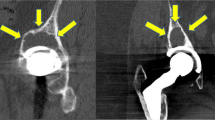Abstract
We measured the size and volume of the femoral broaches and stems supplied with three commercial total hip replacement (THR) systems (JRI Furlong, Biomet Stanmore, and Howmedica Exeter). Using an in vitro method, we created cement mantles that could be directly measured. The broaches supplied with the Biomet Stanmore and the Howmedica Exeter systems allowed the creation of significantly thicker cement mantles than the JRI broaches and stems (Stanmore mean thickness = 1.7 mm, defects at 3% of measurement sites; Exeter mean thickness = 2.0 mm, no defects; JRI mantles mean thickness = 0.9 mm, cement defects at 29% of measurement sites). We conclude that, in vivo, the broaches supplied with the Stanmore and Exeter systems are significantly larger than the corresponding stems, and will excavate a cavity large enough to accommodate the appropriate femoral stem surrounded by an intact cement mantle.
Résumé
Nous avons mesuré la dimension et le volume des alésoirs fémoraux et des tiges fournis avec trois systèmes commerciaux de PTH (Furlong JRI, Biomet Stanmore, Howmedica Exeter). Utilisant une méthode in vitro, nous avons créé des manteaux de ciment qui pouvaient être mesurées directement. Les alésoirs des systèmes Biomet Stanmore et Howmedica Exeter ont autorisé la création de manteaux de ciment considérablement plus épais que dans le système JRI (Stanmore épaisseur moyenne = 1.7 mm, défauts sur 3% d’emplacements de la mesure; Exeter épaisseur moyenne = 2.0 mm, aucuns défauts; JRI épaisseur moyenne = 0.9 mm, défauts du ciment à 29% d’emplacements de la mesure). Nous concluons que, in vivo, les alésoirs fournis avec les systèmes Stanmore et Exeter sont nettement plus grands que les tiges correspondantes, et font une cavité assez grande pour recevoir la tige fémorale appropriée entourée par d’une manteau de ciment intact.
Similar content being viewed by others
References
Alho A, Lepisto J, Ylinen P, Paavilainen T (2000) Cemented Lubinus and Furlong total hip endoprosthesis: a 12-year follow-up study of 175 hips comparing the cementing technique. Arch Orthop Trauma Surg 120:276–280
Anthony PP, Gie GA, Howie CR, Ling RSM (1990) Localised endosteal bone lysis in relation to the femoral components of cemented total hip arthroplasties. J Bone Joint Surg [Br] 72:971–979
Barrack RL, Mulroy RD, Harris WH (1992) Improved cementing techniques and femoral component loosening in young patients with hip arthroplasty. J Bone Joint Surg [Br] 74:385–389
Beckenbaugh RD, Ilstrup DM (1978) Total hip arthroplasty. A review of three hundred and thirty-three cases with long follow-up. J Bone Joint Surg [Am] 60:306–313
Crawford RW, Gie G, Ling RSM et al (1997) Periprosthetic femoral osteolysis: an anatomical explanation. Proc Br Orth Res Soc :41
Crawford RW, Murray D (1998) Early failure of cemented designs. Current Orthopaedics 12:244–250
Ebramzadeh E, Sarmiento A, McKellop HA, Llinas A, Gogan W (1994) The cement mantle in total hip arthroplasty. J Bone Joint Surg [Am] 76:77–87
Gerritsma-Bleeker CLE, Deutman R, Mulder ThJ and Steinberg JDJ (2000) The Stanmore total hip replacement. A 22-year follow-up. J Bone Joint Surg [Br] 82:97–102
Huiskes R (1980) Some fundamental aspects of human joint replacement: analysis of stress and heat conduction in bone-prosthesis structures. Acta Orthop Scand [Suppl] 185: 1–208
Jasty M, Maloney WJ, Bragdon CR, O’Connor DO, Haire T, Harris WH (1991) The initiation of failure in cemented femoral components of hip arthroplasties. J Bone Joint Surg [Br] 73:551–558
Joshi RP, Eftekhar NS, McMahon DJ, Nercessian OA (1998) Osteolysis after Charnley primary low friction arthroplasty. J Bone Joint Surg [Br] 80:585–590
Kwak BM, Lim OK, Kim YY, Rim K (1979) An investigation of the effect of cement thickness on an implant by finite element stress analysis. Int Orthop 2:315–319
Langlais F, Kerboull M, Sedel L and Ling RSM (2003) The ‘French Paradox’. J Bone Joint Surg [Br] 85:17–20
Malchau H, Herberts P (1998) Prognosis of total hip replacement. Revision and re-revision rate in total hip replacement: a revision-risk study of 148,359 primary operations, 65th annual meeting of the American Academy of Orthopaedic Surgeons
Mellor SJ, Ripley LG and Ricketts DM (2001) The femoral cement mantle in JRI Furlong total hip replacements. Hip International 11:191–200
Mulroy RD, Harris WH (1990) The effect of improved cementing techniques on component loosening in total hip replacement: an 11-year radiographic review. J Bone Joint Surg [Br] 72:757–760
Skinner JA, Todo S, Taylor M, Wang JS, Pinskerova V, Scott G (2003) Should the cement mantle around the femoral component be thick or thin? J Bone Joint Surg [Br] 85:45–51
Smith SW, Estok DM, Harris WH (1998) Total hip arthroplasty with use of second-generation cementing techniques. An eighteen-year average follow-up study. J Bone Joint Surg [Am] 80:1632–1640
Stauffer RN (1982) Ten-year follow-up study of total hip replacement: with particular reference to roentgenographic loosening of the components. J Bone Joint Surg [Am] 64:983–990
Sutherland CJ, Wilde AH, Borden LS, Marks KE (1982) A ten-year follow-up of one hundred consecutive Muller curved-stem total hip replacement arthroplasties. J Bone Joint Surg [Am] 64:970–982
Warrren PJ, O’Doherty D, Scott G, Greenough CG (1993) The Furlong total hip: satisfactory interim results of a new cemented arthroplasty. J Orth Rheumatol 6:33–36
Acknowledgement
We would like to thank Mr. D. Hitchin at The University of Sussex, and Mr. R. Newson at King’s College, London, for statistical advice. We are also indebted to Joint Replacement Instrumentation Ltd., Biomet, and Stryker Howmedica for providing femoral stems and broaches.
Author information
Authors and Affiliations
Corresponding author
Additional information
This research was supported in part by a grant from The Sprint Fund. No benefits of any form have been received or will be received from a commercial party related directly or indirectly to the subject of this article.
Rights and permissions
About this article
Cite this article
Mellor, S.J., Ripley, L.G. & Ricketts, D.M. The femoral cement mantle in three total hip replacements. International Orthopaedics (SICOT) 28, 40–43 (2004). https://doi.org/10.1007/s00264-003-0509-y
Accepted:
Published:
Issue Date:
DOI: https://doi.org/10.1007/s00264-003-0509-y




